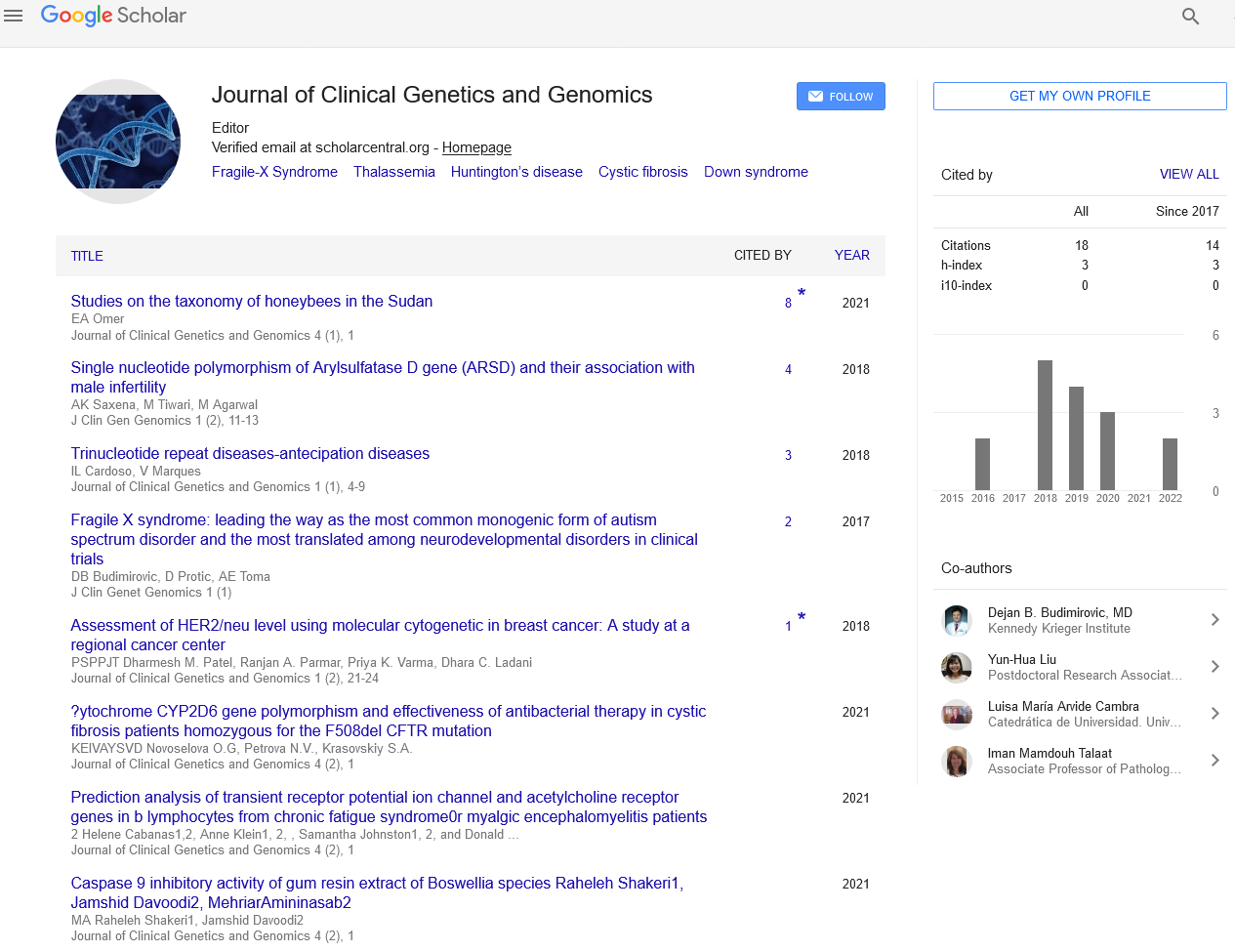Modeling improvements for mitochondrial disease caused by mt-tRNA mutations: Patients' brain in a dish
Received: 02-Feb-2022, Manuscript No. PULJCGG-22-5478; Editor assigned: 04-Feb-2022, Pre QC No. PULJCGG-22-5478 (PQ); Accepted Date: Feb 15, 2022; Reviewed: 09-Feb-2022 QC No. PULJCGG-22-5478 (Q); Revised: 11-Feb-2022, Manuscript No. PULJCGG-22-5478 (R); Published: 16-Feb-2022, DOI: 10.37532/ puljcgg.22.5 (1).1-2
Citation: Brooks S. Modeling improvements for mitochondrial disease caused by mt-tRNA mutations: patients' brain in a dish.J.Clin.Genet.Genom. 2022;5(1):1-2
This open-access article is distributed under the terms of the Creative Commons Attribution Non-Commercial License (CC BY-NC) (http://creativecommons.org/licenses/by-nc/4.0/), which permits reuse, distribution and reproduction of the article, provided that the original work is properly cited and the reuse is restricted to noncommercial purposes. For commercial reuse, contact reprints@pulsus.com
Abstract
A diverse range of uncommon genetic abnormalities known as mitochondrial diseases can result from mutations in either the nuclear (nDNA) or mitochondrial DNA (mtDNA). Multiple maternally inherited genetic illnesses are linked to mtDNA mutations, with mitochondrial dysfunction as a key clinical trait. Although typically multisystemic, these disorders mostly affect the brain and skeletal muscles, two organs that demand a lot of energy. The discovery of induced pluripotent stem cells (iPSCs), in contrast to the challenge of acquiring neuronal and muscle cell models, has aided in the understanding of mitochondrial illnesses. A suitable cellular model is still difficult to come by, which makes it difficult to develop novel treatments for those who suffer from these disorders. In this review, we expand our understanding of the current therapeutic models for the two most well-studied mt-tRNA mutation-caused mitochondrial diseases, MELAS (mitochondrial encephalomyopathy, lactic acidosis, and stroke-like episodes) and MERRF (myoclonic epilepsy with ragged red fibres) syndromes. We will focus on the creation of induced neurons (iNs), which are produced by direct reprogramming of fibroblasts taken from individuals with the MERRF syndrome. This innovative paradigm for studying mitochondrial diseases will be discussed in particular. Because iNs might replicate the pathophysiology of patients' neurons and provide us with the chance to fix the flaws, we believe that they will be useful for modelling mitochondrial illness. Since iNs could imitate patients' neuron pathophysiology and provide us with the chance to fix the changes in one of the most impacted cellular types in these disorders, we anticipate that iNs will be useful for modelling mitochondrial disease.
Key Words
Epilepsy; Mitochondrial; Pradigm; Syndrome; Phluripotent; Encephalomyopathy
Introduction
A Most eukaryotic cells have mitochondria, which are tiny, mobile, and flexible organelles found in the cytoplasm. These organelles are in charge of crucial cellular functions, including controlling apoptosis, maintaining calcium homeostasis, and producing reactive Oxygen Species (ROS). However, Oxidative Phosphorylation (OXPHOS), which occurs in the mitochondrial respiratory chain, is the primary activity of mitochondria (MRC). The circular, doublestranded DNA called Mitochondrial DNA (mtDNA) is found inside mitochondria. The mitochondrial genome contains 16,569 nucleotide pairs that code for 22 transfer RNAs, 13 proteins, and two parts of ribosomal RNA (tRNAs) The inner and outer mitochondrial membranes (IMMs and OMMs, respectively) that define the internal matrix and the intermembrane space are the two membranes that make up the mitochondrial structure. The IMM surface is enlarged by the presence of many folds called cristae that project into the matrix. The Inner Boundary Membrane (IBM) and the cristae membrane (CM), which are joined by cristae junctions, can be used to further divide this membrane into two compartments. Despite the fact that IMM is regarded as a continuous membrane, lateral membrane protein diffusion is constrained, and IBM and CM show an asymmetric protein distribution. The efficiency of OXPHOS, mitochondrial biogenesis, and remodelling depends on this variability. The inner and outer mitochondrial membranes are primarily distinct, but they are only loosely coupled at contact areas that are involved in the formation of cristae. The intermembrane space composition is identical to that of the cytosol because the OMM, which contains several copies of the transport protein porin, is more permeable than the IMM. The IMM is, however, particularly impermeable to ions because of the presence of cardiolipin, and it is selectively permeable to small molecules needed by matrix enzymes because of the presence of numerous transport proteins. Mitochondria rely on the MRC components, which are five multiprotein complexes whose polypeptides are encoded by both nuclear DNA (nDNA) and mtDNA, with nDNA making the largest contribution. Because of this, both genomes are necessary for mitochondrial function. The mitochondrial membrane potential (m), a sign of healthy mitochondria, is produced by an electrochemical proton gradient created by four of these components (Complexes IIV), which are engaged in electron transfer and proton pumping across the IMM. ATP production is driven by the passage of protons into the matrix through the ATP synthase There is currently agreement that these components, which are structured into super complexes (SCs) with a wide range of stoichiometries, are organised at a higher level. Since OPA1, a protein that is essential for mitochondrial fusion and plays a crucial role in SC formation, is knocked down, SC assembly and stability are dependent on the shape of the mitochondrial cristae. Additionally, cristae density and SC assembly are influenced by cellular mechanisms like the Unfolded Protein Response (UPR), which enhances mitochondrial respiratory performance under dietary stress situations. As a result, this higher level of structure is flexible and changes depending on the cell's energetic state. Studies on the structure of cells and computational modelling show that SC assembly promotes electron transmission, avoids protein aggregation, and maintains the structural organisation of MRC components. Nevertheless, despite thorough research, SC functional relevance is still uncertain.
In addition to cardiovascular diseases and neurological conditions like Huntington's and Parkinson's disease, defects in mitochondrial activity have also been related to inherited mitochondrial diseases.





